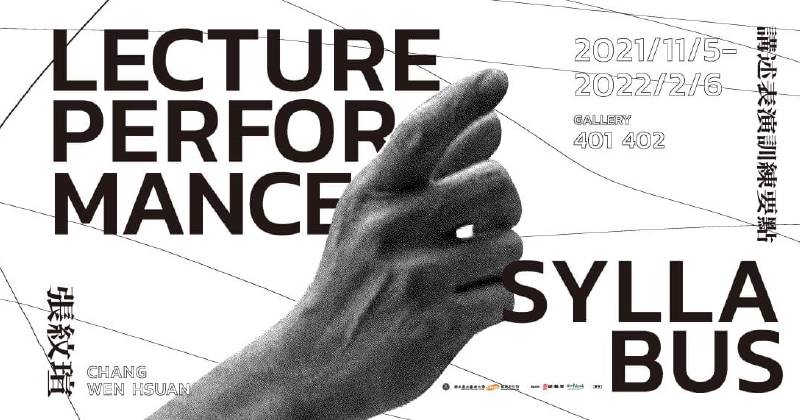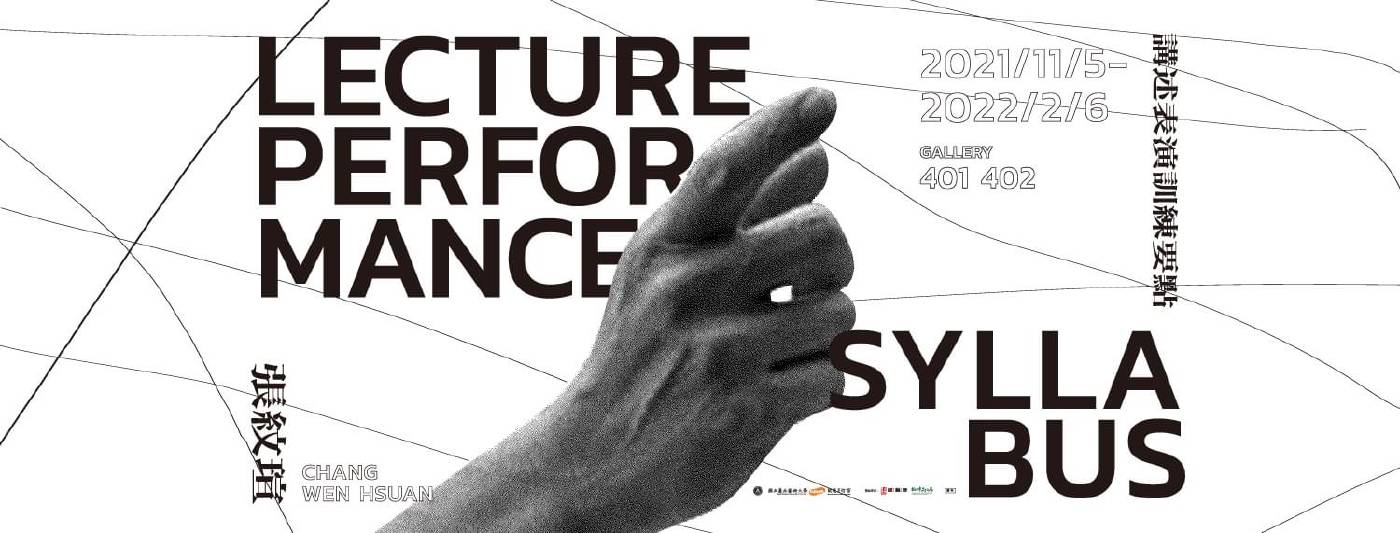國立臺北藝術大學關渡美術館
【講述表演訓練要點】張紋瑄個展

-
展期
日期:2021-11-05 ~ 2022-02-06
-
地點
台北市北投區學園路一號
-
參展藝術家
張紋瑄
-
▌講述表演訓練要點 ▌
張紋瑄
一、訓練宗旨及依據
本訓練依據著以下原則施行:「講述表演並沒有創造新的形式、新的現實主義或是新的敘事,而是將既存的形式、現實主義及敘事重新思考為觀念間的對話。」本句諧擬自蒂莫西.科里根(Timothy J. Corrigan)在 〈論論文電影的歷史:從維托夫到瓦爾達〉文中,談論文電影的句子,原句主詞為論文電影。
二、訓練目標
(一)具備充足的敘事技術,熟練得以扭轉劣勢、掌握人心的說故事程序。
(二)培養說話時合宜的體態及姿勢,力求建構性格立體、說話可信且具有權力感的角色。
(三)訓練聲音使用,並結合敘事技術與身體語言,以在他人面前形塑綜合性的影音經驗。
(四)加強在日常生活中訓練講述表演,使其不只是一種創作形式,不僅自己在時時刻刻都練習,也將所有人的言行都以講述表演來審視。
三、訓練對象
(一)追求成功並想了解如何掌控他人的所有人。
(二)追求自由並想了解如何不受他人掌控的所有人。
(三)所有人。
四、訓練內容
(一)了解自身因為國籍、性別、族群等先天因素而造成的發展困境,透過向國家學習說故事技術,以「國家成功敘事學」修正「個人成功心理學」在21世紀的侷限,並達成目標。詳細訓練內容請參見《魚尾獅是何時絕種的?21世紀成功敘事學》。
(二)繼續第一點訓練內容,觀察、分析並學習優秀範本的姿勢,包含行走、坐下、說話等,了解如何拆解動作,以及特定場合與說話姿勢的交互作用,並在日常生活演練。詳細訓練內容請參見《裝備秀》。
(三)繼續第一點及第二點訓練內容,理解言語及行動、講述及表演、聲音及影像之間的共謀關係,學習聲音表演,熟練操作音畫關係的技術。詳細訓練內容請參見《腹語術士》。
五、本要點經亞洲四小龍決議通過,經歷史事實審視備查後施行,修正時亦同。
▌張紋瑄 ▌
張紋瑄的藝術實踐透過重讀、重寫及虛構出另類方案,來質問機構化的歷史敘事結構,並同時暴露出潛藏在歷史敘事中,不同權力之間的角力關係,而此暴露結構的手段,也正是一種重新處理個人故事及歷史書寫之間的關係及能動性的方式。藉由不同的媒介——包含裝置、錄像及講述——的使用,他經常用與原件有誤差的檔案以及第一人稱敘事,讓觀者得以反思歷史如何影響了當下的形塑與未來的推進。近期展覽包括:「Re: Play 操/演現場」(空總臺灣當代文化實驗場C-Lab,台北,2020);「MaytoDay」(亞洲文化殿堂,光州,2020);「非黑/非紅/非黃/非女」(時代藝術中心,柏林,2019);「2018台灣美術雙年展:野根莖」(國立台灣美術館,台中,2018);「穿越─正義:科技@潛殖」(台北當代藝術館,台北,2018)等。自2018年起開啟〈書寫公廠Writing FACTory〉長期計劃。2019年參與新加坡NTU CCA駐留研究計畫。
▰▰▰▰▰▰▰▰▰▰▰▰▰▰▰▰▰▰▰▰▰▰▰▰▰▰▰▰▰▰▰▰▰▰▰▰▰▰▰▰▰▰▰▰▰▰▰▰▰▰
▌Lecture Performance Syllabus ▌
Chang Wen-Hsuan
I. Training Purpose and Basis
This training is implemented on the basis of the following principle: “Lecture performance does not create new forms of experimentation, realism, or narrative; it rethinks existing ones as a dialogue of ideas.” This is appropriated from Timothy J. Corrigan’s statement regarding essay film in On the History of the Essay Film: Vertov to Verda. The original subjects of the sentence were “essay and essay film.”
II. Training Objectives
(1) To be equipped with sufficient narrative techniques, and be skilled in tide-turning and captivating story-telling processes.
(2) To nurture appropriate postures and gestures when talking, in aim to construct a role with outstanding personality, credibility, and authority.
(3) To train use of voice, while also combining narrative techniques and body language to shape comprehensive audio-visual experience in front of others.
(4) To strengthen the training of lecture performance in daily life, so that it is more than just an art form; in addition to practicing at all times, also examine other’s behaviors from the perspective of lecture performance.
III. Subjects of Training
(1) Everyone who pursues success and wants to know how to control others.
(2) Everyone who pursues freedom and wants to know how not to be controlled by others.
(3) Everyone.
IV. Training Content
(1) Understand own development barriers resulted from innate factors, such as nationality, gender, and ethnicity, and, through learning story-telling technique from countries, use “National Narratology of Success” to correct the limitations of “individual psychology of succes” in the 21st century and achieve goals. Refer to When Did the Merlion Become Extinct? – The Narrative to Succeed in the 21st Century for training details.
(2) Continuation of (1); observe, analyze, and learn from outstanding examples’ postures, including walking, sitting down, and speaking; understand how to dissect movements and the interaction of specific situations and speech postures, and practice in daily life. Refer to The Equipment Show for training details.
(3) Continuation of (1) and (2); understand the conspiracy between speech and action, lecture and performance, and audio and visual; learn voice performance and familiarize with the operations of the relationship of voice and image. Refer to The Ventriloquist for training details.
V. These Directions shall be approved by the Four Asian Tigers, and ratified through review of historical facts prior to taking effect. Amendments shall be processed accordingly.
▌Chang Wen-Hsuan ▌
The artistic practice of Chang Wen-Hsuan questions the narrative structure of institutionalised history with re-readings, re-writing, and suggestions of fictional alternatives. To expose the power tensions embedded in historical narratives is a way of managing the relationships and dynamics between individual stories and the writing of history. Through versatile platforms including installations, videos, and lectures, she often navigates skewed documentations and first-person accounts to trigger reflections on how the understanding of history affects the purport of the present and thrust of the future.
Recent exhibitions include: “Re: Play” (Taiwan Contemporary Culture Lab, Taipei, 2020); “MaytoDay” (Asia Culture Center (ACC), Gwangju, 2020); “Neither black/red/yellow nor woman” (Times Art Center Berlin, Berlin, 2019); “2018 Taiwan Biennial: Wild Rhizome” (National Taiwan Museum of Fine Arts, Taichung, 2018); “Trans-Justice: Para-Colonial@Technology” (MOCA Taipei, Taipei, 2018) In 2018, she launched Writing FACTory. And in 2019, she participated in an artist-in-residence program in NTU CCA, Singapore
推薦展覽
view all國立臺北藝術大學關渡美術館
【從你的窗櫺開始綻放以來—安德利亞.梅達爾個展】Since the Wood of Your Window Has Been Blooming-Andreea Medar
日期:2025-03-07 ~ 2025-05-18|台灣,台北市
42 days left